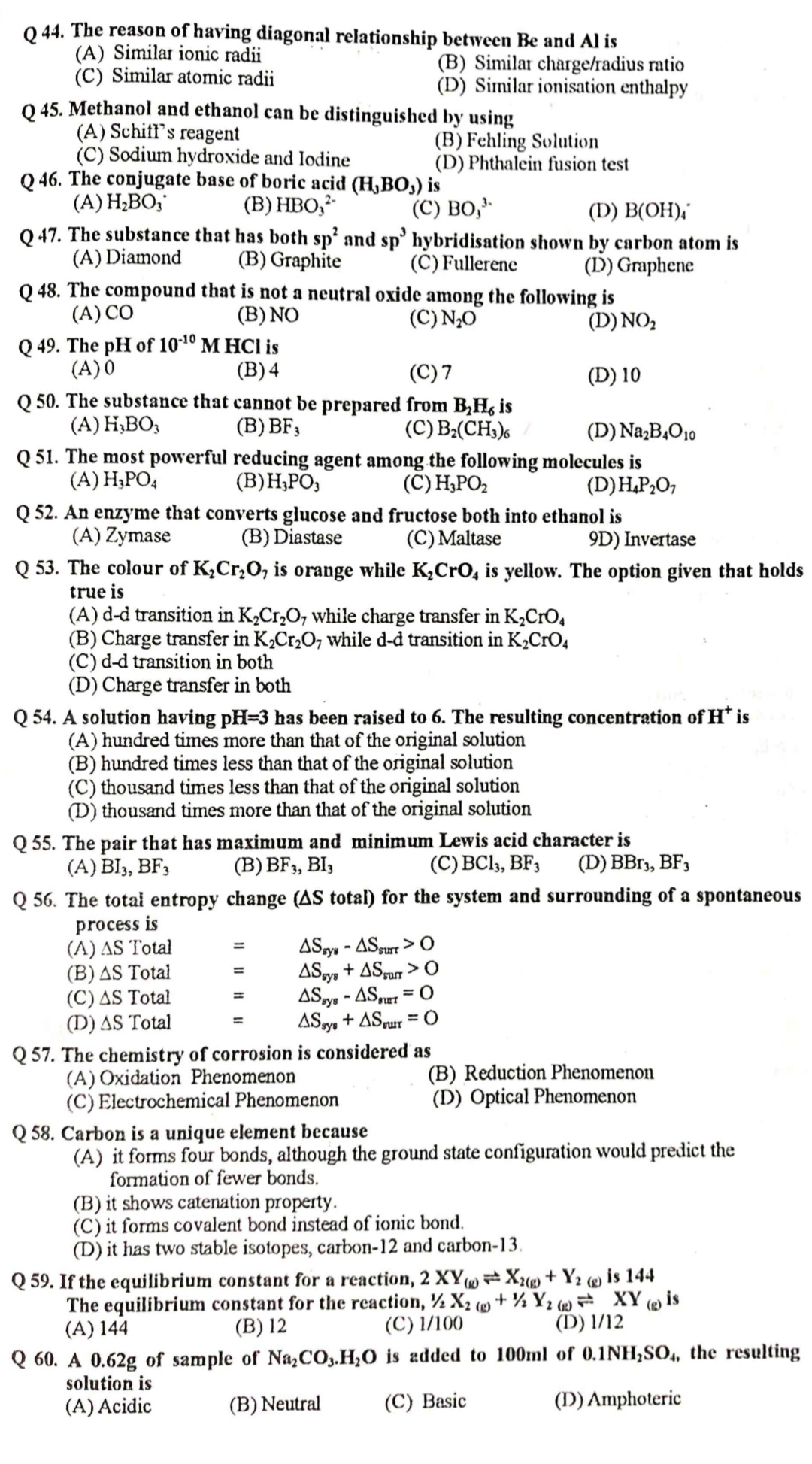The reason for having diagonal relationship between Be and Al is (A) Similar ionic radii (B) Similar charge/radius ratio (C) Similar atomic radii (D) Similar ionisation enthalpy.... The reason for having diagonal relationship between Be and Al is (A) Similar ionic radii (B) Similar charge/radius ratio (C) Similar atomic radii (D) Similar ionisation enthalpy. Methanol and ethanol can be distinguished by using (A) Schifťs reagent (B) Fehling Solution (C) Sodium hydroxide and Iodine (D) Phthalein fusion test. The conjugate base of boric acid (H3BO3) is (A) H2BO3- (B) HBO2- (C) BO3- (D) B(OH)4. The substance that has both sp2 and sp3 hybridisation shown by carbon atom is (A) Diamond (B) Graphite (C) Fullerene (D) Graphene. The compound that is not a neutral oxide among the following is (A) CO (B) NO (C) N2O (D) NO2. The pH of 10^-10 M HCl is (A) 0 (B) 4 (C) 7 (D) 10. The substance that cannot be prepared from B2H6 is (A) H3BO3 (B) BF3 (C) B2(CH3)6 (D) Na2B4O10. The most powerful reducing agent among the following molecules is (A) H3PO4 (B) H3PO3 (C) H3PO2 (D) H4P2O7. An enzyme that converts glucose and fructose both into ethanol is (A) Zymase (B) Diastase (C) Maltase (D) Invertase. The colour of K2Cr2O7 is orange while K2CrO4 is yellow. The option given that holds true is (A) d-d transition in K2Cr2O7 while charge transfer in K2CrO4 (B) Charge transfer in K2Cr2O7 while d-d transition in K2CrO4 (C) d-d transition in both (D) Charge transfer in both. A solution having pH=3 has been raised to 6. The resulting concentration of H+ is (A) hundred times more than that of the original solution (B) hundred times less than that of the original solution (C) thousand times less than that of the original solution (D) thousand times more than that of the original solution. The pair that has maximum and minimum Lewis acid character is (A) B2H6, BF3 (B) BF3, B13 (C) BCl3, BF3 (D) BB3, BF3. The total entropy change (ΔS total) for the system and surrounding of a spontaneous process is (A) ΔS Total = ΔS sys - ΔS surr > 0 (B) ΔS Total = ΔS sys + ΔS surr > 0 (C) ΔS Total = ΔS sys - ΔS surr = 0 (D) ΔS Total = ΔS sys + ΔS surr = 0. The chemistry of corrosion is considered as (A) Oxidation Phenomenon (B) Reduction Phenomenon (C) Electrochemical Phenomenon (D) Optical Phenomenon. Carbon is a unique element because (A) it forms four bonds, although the ground state configuration would predict the formation of fewer bonds. (B) it shows catenation property. (C) it forms covalent bond instead of ionic bond. (D) it has two stable isotopes, carbon-12 and carbon-13. If the equilibrium constant for a reaction, 2 XY (g) ⇌ X2 (g) + Y2 (g) is 144. The equilibrium constant for the reaction, ½ X2 (g) + ½ Y2 (g) ⇌ XY (g) is (A) 144 (B) 12 (C) 1/100 (D) 1/12. A 0.62g of sample of Na2CO3·H2O is added to 100ml of 0.1NH2SO4, the resulting solution is (A) Acidic (B) Neutral (C) Basic (D) Amphoteric.

Understand the Problem
The question set is providing various chemistry-related multiple-choice questions covering topics like hybridization, pH, Lewis acids, and redox reactions. Each question is designed to test knowledge in specific areas of chemistry.
Answer
Q44: Similar charge/radius ratio, Q45: Sodium hydroxide and iodine, Q46: B(OH)4-, Q47: Fullerene, Q48: NO2, Q49: 7, Q50: Na2B4O10, Q51: H3PO2, Q52: Zymase, Q53: Charge transfer in both, Q54: Thousand times less, Q55: BCl3, BF3, Q56: ΔS Total = ΔS sys + ΔS surr > 0, Q57: Electrochemical Phenomenon, Q58: Shows catenation property, Q59: 1/12, Q60: Acidic.
Q44: Similar charge/radius ratio. Q45: Sodium hydroxide and iodine. Q46: B(OH)4-. Q47: Fullerene. Q48: NO2. Q49: 7. Q50: Na2B4O10. Q51: H3PO2. Q52: Zymase. Q53: Charge transfer in both. Q54: Thousand times less than that of the original solution. Q55: BCl3, BF3. Q56: ΔS Total = ΔS sys + ΔS surr > 0. Q57: Electrochemical Phenomenon. Q58: It shows catenation property. Q59: 1/12. Q60: Acidic.
Answer for screen readers
Q44: Similar charge/radius ratio. Q45: Sodium hydroxide and iodine. Q46: B(OH)4-. Q47: Fullerene. Q48: NO2. Q49: 7. Q50: Na2B4O10. Q51: H3PO2. Q52: Zymase. Q53: Charge transfer in both. Q54: Thousand times less than that of the original solution. Q55: BCl3, BF3. Q56: ΔS Total = ΔS sys + ΔS surr > 0. Q57: Electrochemical Phenomenon. Q58: It shows catenation property. Q59: 1/12. Q60: Acidic.
More Information
These answers cover various chemistry concepts, focusing on properties, reactions, and characteristics of elements and compounds.
AI-generated content may contain errors. Please verify critical information